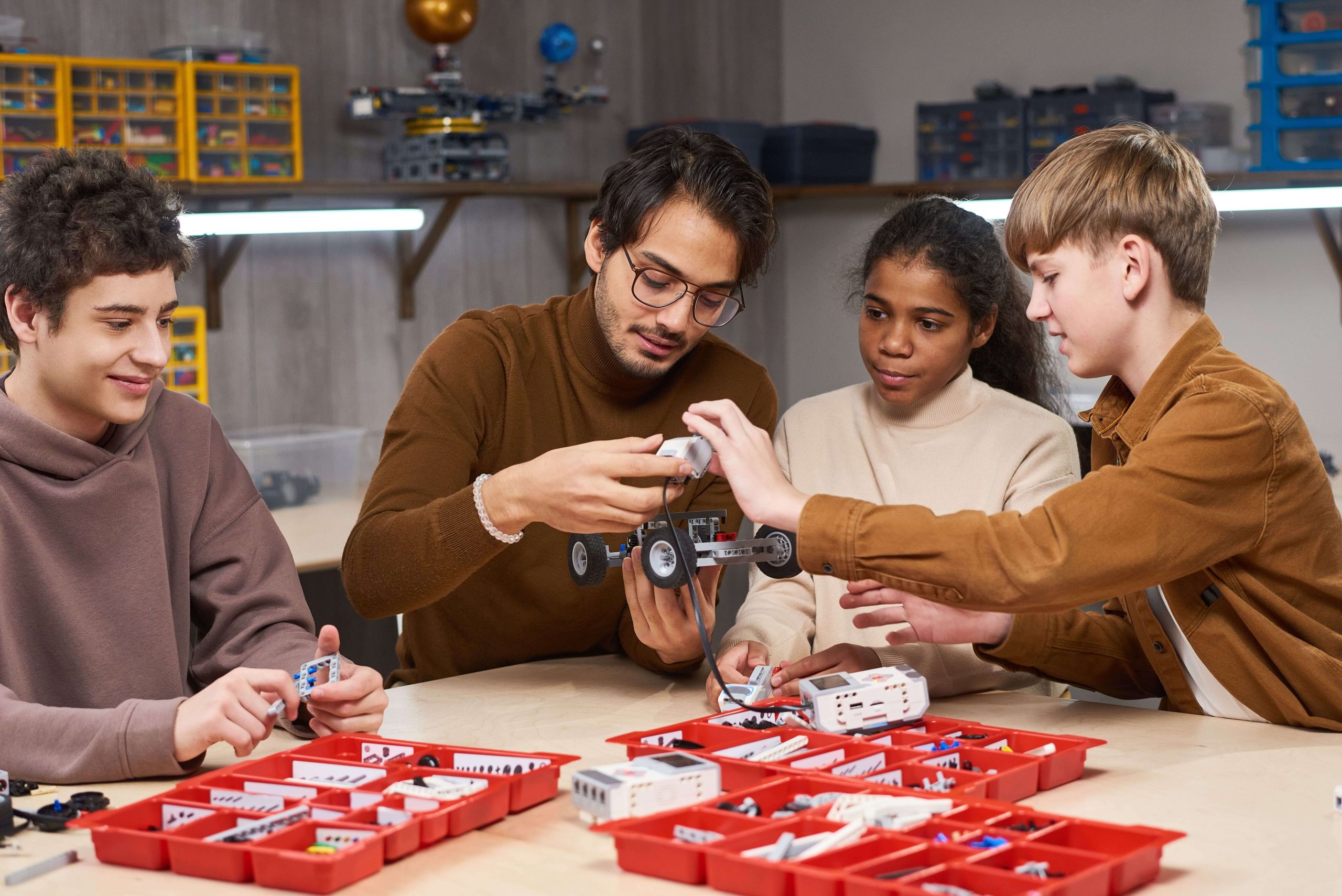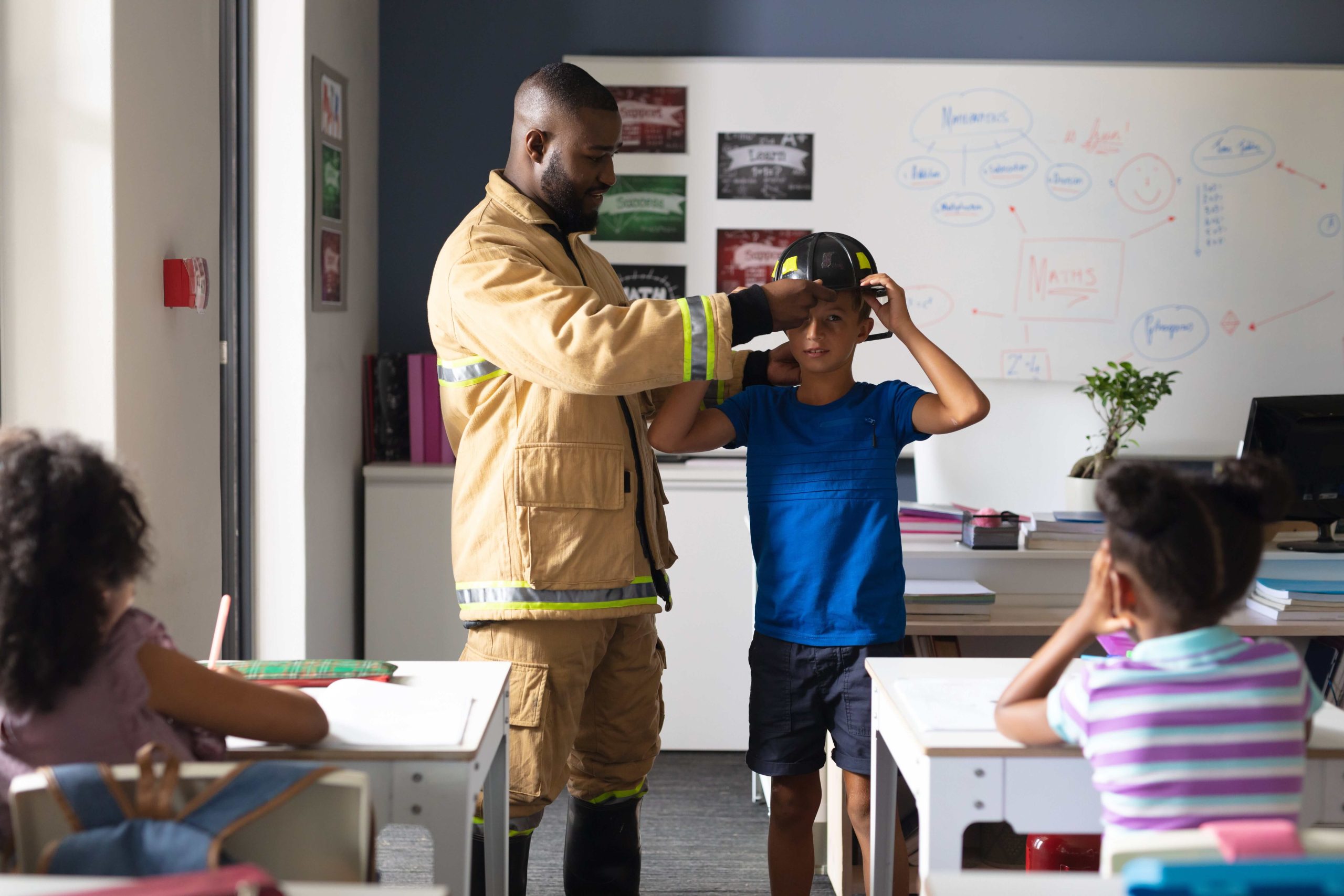STEAM (Science, Technology, Engineering, Arts, and Mathematics) education, a progression from the original STEM (Science, Technology, Engineering, and Mathematics) introduced in early 21st century, is an education framework that stems from (pun intended) the demand to build creativity and critical thinking skills among the youth.
Incorporating the A in STEAM—art—brings in personal expression, empathy, meaning-making and the purpose of what you’re learning.
Dr. Kristin Cook, associate dean of Bellarmine’s Annsley Frazier Thornton School of Education
As educators of 21st century, we want to prepare students to be holistic individuals who are equipped with skills needed for the challenges the current world. And STEAM education is highly relevant in the era of burgeoning Artificial Intelligence, as it empowers students to adapt to the ever-changing landscape, ensuring they are well-prepared for the demands of the future.
So, what is STEAM education, and how can you effectively implement in your classroom? Read on to find out!
What is STEAM Education?
What is STEAM Education?
STEAM stands for Science, Technology, Engineering, Arts, and Mathematics. This interdisciplinary framework aims to equip students with a diverse skill set, to prepare them for a future where cross-disciplinary skills are necessary. Each component of STEAM contributes unique elements to the learning process:
Science: Encourages curiosity, observation, and experimentation, fostering an understanding of the natural world.
Technology: Involves the use of tools, software, and digital platforms to solve problems and enhance learning experiences.
Engineering: Promotes design thinking and problem-solving through hands-on projects and the engineering design process.
Arts: Incorporates creativity and expression through various artistic mediums, fostering a holistic approach to learning.
Mathematics: Provides the foundational skills for logical reasoning, quantitative analysis, and problem-solving.
The goal of STEAM Education is to equip students with the ability to approach challenges from various angles, shaping them into flexible learners, capable of applying various skills to novel situations.
STEM vs STEAM
While STEM focuses on the core subjects of Science, Technology, Engineering, and Mathematics, STEAM injects creativity into the mix by incorporating the Arts. This infusion of artistic elements enhances the problem-solving and critical thinking skills used in STEM.

STEAM is born out of the demand for creativity and critical thinking in addressing complex challenges in the 21st century. It re-inserts the humanizing element into the fields of STEM. In a world where technology intersects with human experiences and societal challenges, the fusion of Arts with STEM disciplines enables students to approach problems with a multifaceted mindset and empathy.
Both STEM and STEAM aim to provide students with a comprehensive education that prepares them for the challenges of the modern world. The choice between STEM and STEAM often reflects educational objectives, with STEAM placing a greater emphasis on the integration of artistic expression and creativity within the curriculum and STEM on analytical thinking.
| STEM | STEAM | |
|---|---|---|
| Focus Areas | Science, Technology, Engineering, Mathematics | Science, Technology, Engineering, Mathematics, Arts |
| Skills Emphasis | Emphasizes analytical thinking, logical reasoning and problem-solving | Integrates creativity as a crucial element in problem-solving and critical thinking |
| Educational Objectives | Focuses on technical proficiency and analytical skills | Aims for a balanced education including creativity, empathy |
Why is STEAM Education Important in 2024?
As industries become more technology-driven and interdisciplinary, individuals educated in STEAM are better equipped to navigate the complexities of the modern workforce due to benefits such as these:
- Adaptability: Combine technical proficiency with creative thinking to equip students with the adaptability needed to navigate the rapidly changing world, especially in the era of burgeoning AI.
- Career Readiness: Students with holistic STEAM skills are positioned to be more economically competitive. STEAM education equips students with a diverse skill set, ensuring they are well-prepared for the dynamic and technology-driven careers of the future.
- Addressing Complex and Evolving Problems: Modern challenges often require an interdisciplinary approach. STEAM education fosters the ability to tackle complex problems by integrating knowledge from various disciplines.
- Interdisciplinary Collaboration: Use STEAM to help students understand how various subjects work together, reflecting the collaborative nature of many modern workplaces and industries.
- Cultural and Artistic Appreciation: The inclusion of arts in STEAM fosters cultural responsiveness and an appreciation for artistic expression, contributing to the development of well-rounded and future-ready individuals.
How to Implement STEAM in the Classroom: 5 Key Strategies
A Common Misconception about STEAM Education
A common misunderstanding about STEAM education is that it solely revolves around teaching science, technology, engineering, arts, and mathematics as separate and isolated subjects. In reality, STEAM emphasizes the integration of these disciplines to encourage a holistic and interdisciplinary approach to learning.
And this can be achieved through the effective integration of the following elements in the classroom:
- Project-Based Learning: Incorporate hands-on, project-based learning activities that encourage students to apply knowledge and skills from multiple disciplines to solve problems.
- Cross-Curricular Connections: Highlight the connections between various STEAM subjects during lessons.
- Technology Integration: The use of education technology is a fundamental aspect of STEAM education. Students learn to leverage technological tools and resources such as these recommended teaching tools and these ChatGPT alternatives to enhance their understanding of the connections between these disciplines through gamification, collaboration, AR and VR, simulations and virtual labs.
- Inquiry-Based Learning: Encourage students to ask questions and perform research that spans multiple disciplines.
- Collaboration and Communication: Encourage collaboration between students to work on their communication skills, both written and verbal.,
14 Simple Tips to Get Started with STEAM Teaching
Implementing STEAM into your classroom can be an exciting and rewarding process. Remember that implementing a new approach is a gradual process, and it’s okay to start small. Over time, you can expand your efforts as you and your students become more comfortable.

Here are some initial ways to get started:
- Prioritize hands-on activities and projects: Engage students in tangible experiences that involve building, experimenting, and problem-solving, fostering a deeper understanding of STEAM concepts.
Refer here for a list of hands-on project-based learning ideas for your STEAM classroom.
- Emphasize real-world applications of STEAM concepts: Connect classroom learning to practical, real-life scenarios, demonstrating the relevance of STEAM in addressing contemporary challenges.
- Provide opportunities for student choice within projects: Foster autonomy and creativity by allowing students to choose aspects of projects, promoting ownership and personalized learning experiences.
- Encourage collaborative learning through group projects: Develop teamwork and communication skills by structuring projects that require students to collaborate, reflecting the collaborative nature of STEAM professions.
Encourage collaboration in the classroom with effective grouping.
- Incorporate artistic expression into STEAM activities: Integrate the arts to stimulate creativity and a holistic understanding, demonstrating how artistic elements enhance problem-solving and innovation in STEM.
- Leverage technology tools and platforms for enhanced learning: Utilize digital tools to enrich lessons, offering interactive learning experiences, simulations, and multimedia learning to enhance understanding and engagement.
Start incorporating tech in your classroom with interactive teaching tools like ClassPoint, to infuse interactive quizzes and gamification in any lesson.
- Arrange field trips to STEAM-related places or invite guest speakers: Provide firsthand experiences by exposing students to real-world applications, industries, and professionals, inspiring a deeper interest in STEAM fields.
- Introduce gamification elements for a more interactive learning experience: Infuse game-based elements to make learning enjoyable, motivating students through challenges and competitions that reinforce STEAM concepts.
Refer here for a repository of gamification ideas you can incorporate in your STEAM classroom.
- Connect STEAM concepts to current events or contemporary issues: Relate classroom content to real-world situations, demonstrating the immediate impact and relevance of STEAM in addressing societal challenges.
- Showcase student work through presentations, exhibitions, or science fairs: Provide platforms for students to display their projects and findings, fostering confidence, communication skills, and a sense of accomplishment.
- Allow time for students to explore their interests within the STEAM framework: Nurture curiosity by giving students the flexibility to delve into specific areas of interest, encouraging a passion-driven approach to learning.
- Encourage reflection activities for metacognition and a deeper understanding: Foster self-awareness and critical thinking by incorporating reflection exercises, helping students understand their learning processes and improve problem-solving skills.
Explore a list of Cognitive Learning Ideas to help build metacognitive skills among your students.
- Attend workshops or seek professional development opportunities to enhance your understanding: Stay updated on the latest teaching methods and resources, continuously improving your ability to effectively integrate STEAM into the curriculum.
- Work with other teachers in your school or district to share resources and ideas: Collaborate with colleagues to create a supportive network for sharing best practices, resources, and innovative approaches to STEAM education.
8 Ideas to Amplify the Fun in STEAM Classrooms of All Ages
STEAM activities seamlessly integrate various disciplines into enjoyable and educational experiences. Whether constructing new structures with Legos, blending technical aspects with art projects, or coding interactive programs to unravel the world of technology, these activities offer a dynamic platform for hands-on exploration.

- Building Structures
- Younger Ages: Utilize building blocks or everyday items (such as straws and marshmallows) to construct simple structures.
- Older Ages: Introduce engineering principles by challenging students to build more intricate structures using materials like toothpicks, spaghetti, or popsicle sticks.
- Coding Challenges
- Younger Ages: Engage in visual coding apps or games to introduce basic coding concepts.
- Older Ages: Explore coding languages like Scratch, Python, or JavaScript to create interactive projects or games.
- Math Puzzles and Games
- Younger Ages: Incorporate enjoyable math puzzles, board games, or activities involving counting, sorting, and basic arithmetic.
- Older Ages: Tackle more complex math puzzles, logic games, or mathematical challenges to enhance problem-solving skills.
Try this pre-made PowerPoint puzzle template for an interactive puzzle game.
- Water Rocket Launch
- Younger Ages: Create simple water rockets using plastic bottles to introduce basic principles of physics and launching.
- Older Ages: Construct more advanced water rockets with added features for a deeper exploration of aerodynamics and launch dynamics.
- Solar Oven Cooking
- Younger Ages: Build basic solar ovens using cardboard and aluminum foil to cook simple snacks or heat items using solar energy.
- Older Ages: Engineer more sophisticated solar ovens with additional design elements for cooking experiments and discussions on solar power.
- Magnetic Slime
- Younger Ages: Engage in a basic magnetic slime-making activity to explore the playful side of magnets and slimy textures.
- Older Ages: Dive into a more comprehensive understanding of magnetism and chemistry by creating advanced variations of magnetic slime.
- DIY Kaleidoscope
- Younger Ages: Craft simple kaleidoscopes using cardboard tubes, mirrors, and colorful materials to introduce basic optics and the joy of creating patterns.
- Older Ages: Engineer intricate kaleidoscopes with additional design components, discussing more advanced concepts related to optics and light patterns.
- Environmental Engineering Challenges
- Younger Ages: Teach students basic principles of environmental problems and solutions such as trash sorting, water filtration and planting for a purpose.
- Older Ages: Participants research environmental issues, design engineering solutions to address a specific problem (e.g., waste reduction), annotate their designs using ClassPoint, and present their ideas and solutions to the audience.
Engage interactive teaching tools such as Drag and Drop, and annotation tools for engaging presentations.
For a comprehensive collection of STEAM lesson plans, feel free to explore the resources below or the lesson plans from PBS or Nasco Education for detailed guides and inspiration.
The Future of STEAM Education: What to Expect
Overall, the future of STEAM education will be characterized by continuous adaptation, underscoring the importance of staying agile and integrating new methodologies and tools to equip students for the future.

Emerging technologies, such as artificial intelligence and virtual reality, are anticipated to play a pivotal role in transforming STEAM education. These tools will offer more immersive learning experiences, heightening students’ engagement and understanding. Global collaboration is poised to become increasingly prevalent, allowing students from diverse backgrounds to collaborate on projects and fostering cross-cultural perspectives and collaborative problem-solving.
Another notable trend to observe is the shift towards personalized learning paths. By leveraging adaptive platforms and data analytics, teachers can customize educational content for individual students. In response to pressing environmental challenges, integrating ecological perspectives into the curriculum will become more widespread, encouraging students to explore sustainable solutions.
Final Thoughts
Know you have a comprehensive and concise overview of STEAM education, it is time to incorporate STEAM education in your classroom. By breaking down subject boundaries, fostering creativity, and promoting real-world problem-solving through STEAM, you can inspire and guide your students to develop the diverse skills needed in today’s rapidly evolving world.
Learn a wide range of other 21st century teaching pedagogies here.
